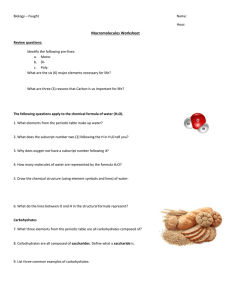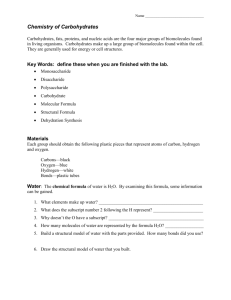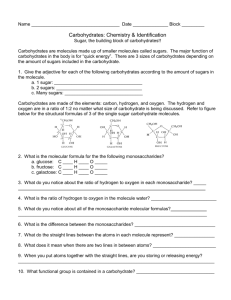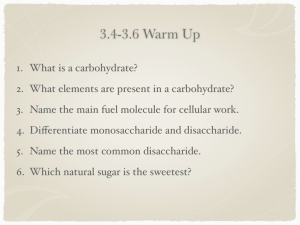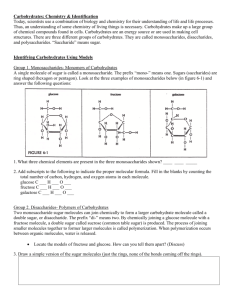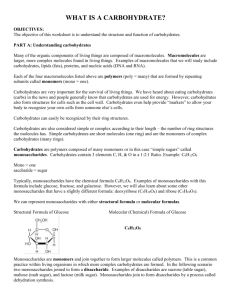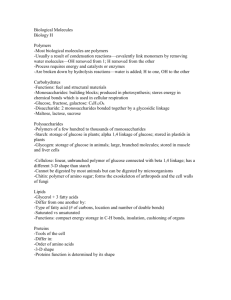LAB-AIDS#505-10 CHEMISTRY OF CARBOHYDRATES KIT
advertisement
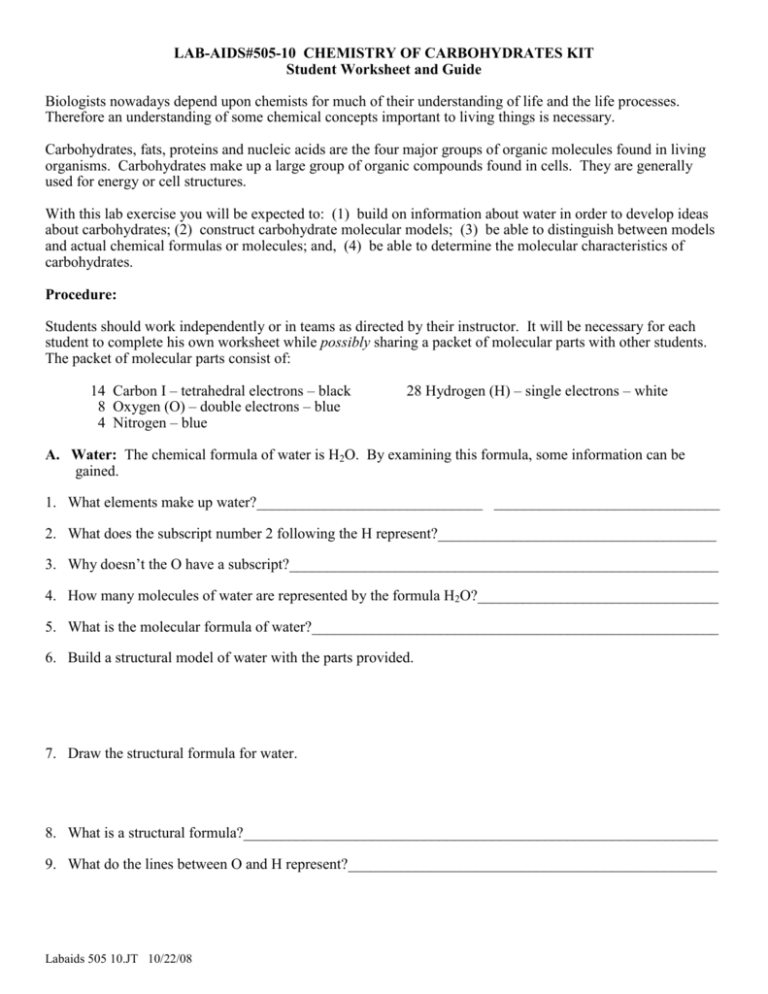
LAB-AIDS#505-10 CHEMISTRY OF CARBOHYDRATES KIT Student Worksheet and Guide Biologists nowadays depend upon chemists for much of their understanding of life and the life processes. Therefore an understanding of some chemical concepts important to living things is necessary. Carbohydrates, fats, proteins and nucleic acids are the four major groups of organic molecules found in living organisms. Carbohydrates make up a large group of organic compounds found in cells. They are generally used for energy or cell structures. With this lab exercise you will be expected to: (1) build on information about water in order to develop ideas about carbohydrates; (2) construct carbohydrate molecular models; (3) be able to distinguish between models and actual chemical formulas or molecules; and, (4) be able to determine the molecular characteristics of carbohydrates. Procedure: Students should work independently or in teams as directed by their instructor. It will be necessary for each student to complete his own worksheet while possibly sharing a packet of molecular parts with other students. The packet of molecular parts consist of: 14 Carbon I – tetrahedral electrons – black 8 Oxygen (O) – double electrons – blue 4 Nitrogen – blue 28 Hydrogen (H) – single electrons – white A. Water: The chemical formula of water is H2O. By examining this formula, some information can be gained. 1. What elements make up water?______________________________ ______________________________ 2. What does the subscript number 2 following the H represent?_____________________________________ 3. Why doesn’t the O have a subscript?_________________________________________________________ 4. How many molecules of water are represented by the formula H2O?________________________________ 5. What is the molecular formula of water?______________________________________________________ 6. Build a structural model of water with the parts provided. 7. Draw the structural formula for water. 8. What is a structural formula?_______________________________________________________________ 9. What do the lines between O and H represent?_________________________________________________ Labaids 505 10.JT 10/22/08 A. CARBOHYDRATES: An important group of biological compounds are the saccharides (the sugars of carbohydrates). Carbohydrates contain carbon, hydrogen, and oxygen. The many different types of sugars have been grouped into three main categories: monosaccharides disaccharides polysaccharides A. Single sugars or monosaccharides: 1. Study the structural formulas of the three monosaccharides in Fig. 1. H H H C H OH C H O H HO C C H C OH H C C H OH C H OH C H O OH O H H C OH C C H H OH C C OH H H H C C OH H OH OH H C C H OH OH OH GALACTOSE GLUCOSE FRUCTOSE Fig. 1. Structural formulas of three monosaccharides 2. Construct two different models of the monosaccharides. Join with another team so that all three monosaccharides are built and available for two teams. The models constructed represent the three-dimensional shapes of the molecules. They illustrate that individual molecules of carbohydrates do differ from one another in general structural shape even though their molecular formulas are the same. They also will illustrate how it is possible for molecules to join together to form different carbohydrates. 3. How many atoms of carbon are there in each molecule of glucose?_________________________________ fructose? __________________________________ and galactose?________________________________ 4. Write the molecular formulas for glucose_____________________ fructose ______________________ and galactose_____________________. 5. Compare the number of hydrogen atoms to the number of oxygen atoms in each sugar. What is the ratio of hydrogen to oxygen? (i.e., how many hydrogen atoms are there for each oxygen atom?) _________________________________ How do they compare to the ratio in water?__________________ _______________________________________________________________________________________ 6. The structural arrangement of C, H, and O in glucose, fructose, and galactose differs. This helps explain why different model shapes are used for each monosaccharide. Molecules of monosaccharides may have the same molecular formula but differ in three-dimensional structures. This is called isomerism. Using the three models and structural formulas, describes isomerism in your own words. __________________________________________________________________________________________ __________________________________________________________________________________________ Labaids 505 10.JT 10/22/08 2 CARBOHYDRATES CARBOHYDRATES Monosaccharides glucose fructose galactose Labaids 505 10.JT 10/22/08 Disaccharides Polysaccharides sucrose maltose lactose starch glycogen cellulose 3 Labaids 505 10.JT 10/22/08 4
